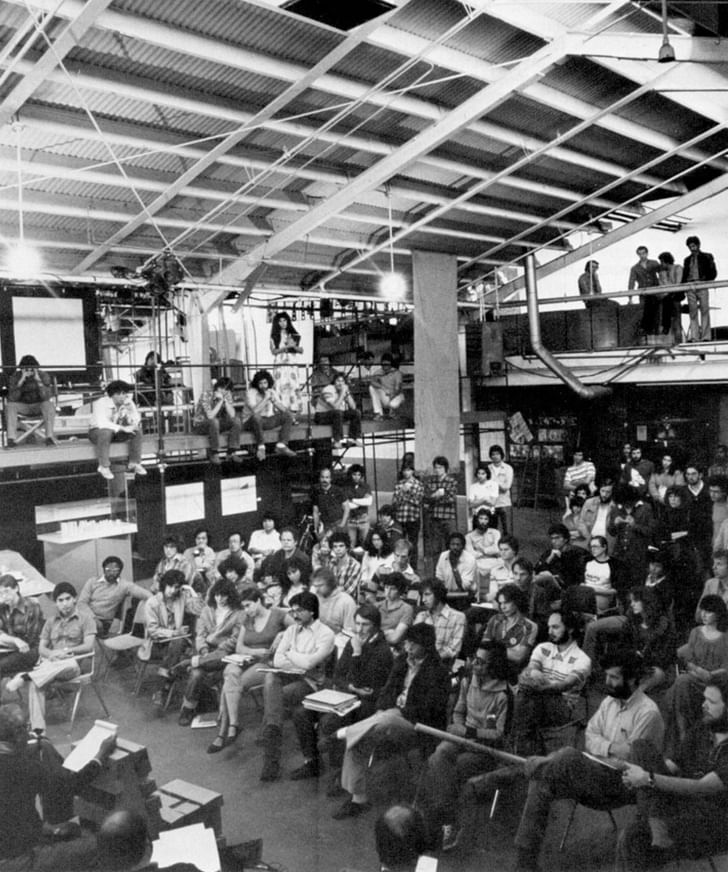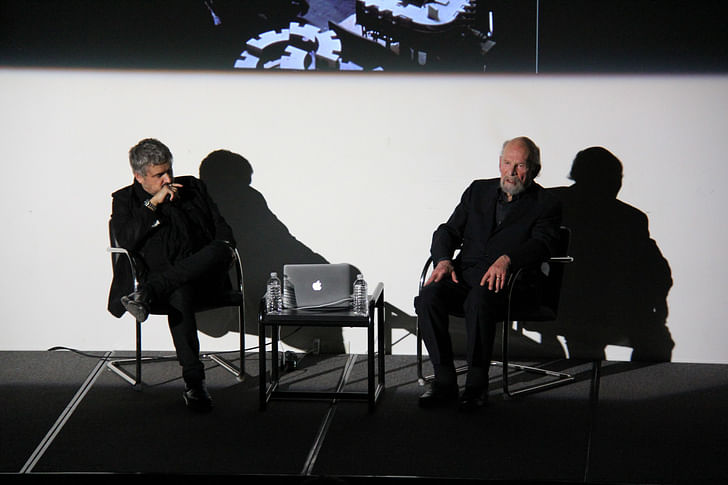

Distinguished by nearly forty-five years of SCI-Arc history between them, founding director Ray Kappe sat with current director Hernan Diaz Alonso last Wednesday evening for a reflective public conversation at the school. Part of SCI-Arc’s “Duel + Duet” speaker series, where a visiting figure is interviewed by a leader at the school, Alonso prompted Kappe to chart the school's historical narrative, touching on both the exciting possibilities and potentially debilitating difficulties inherent to running an independent educational institution – no less true today than they were in the 1970s.
The 88-year-old Kappe explained, in a calmly authoritative growl, how the motivation for SCI-Arc emerged after his resignation from Cal Poly Pomona's architecture department in 1972 – the department which, just four years earlier, he had founded with the late Bernard Zimmerman. While Kappe thought the department had been substantively successful, engendering partnerships with Archigram and attempting interesting work and research, he wasn’t happy with the school’s leadership and the imbalance that he saw his department’s population causing among the landscape and urban planning departments – starting at 25 students, the architecture department had ballooned dramatically to include 350 by its third year. After a testy exchange with the dean, Kappe was asked to resign.

In his words, Kappe’s exit became a “cause célèbre” for others who were also unhappy with the school’s leadership to leave, many of them – including Ahde Lahti, Thom Mayne, Gary Neville, Bill Simonian, Glen Small, James Stafford, and Bernard Zimmerman – joining him in Kappe himself identifies strongly with rationalism and pragmaticism in his practice – a sensibility he saw reflected in the school's association with sciencethe first wave of SCI-Arc’s community. Choosing specifically an institute model of education, distinct from a college or university’s hierarchy, testifies to the anti-establishment rhetoric Kappe felt was necessary after leaving Cal Poly, as was the attachment to the Southern California region rather than a city’s territory, making it more inclusive.
While that seems like a clear enough explanation of SCI-Arc’s acronym, there’s also the shortening of “Science Architecture”, which Kappe also cites as an inspiration for the name (after it shed its initial "New School" title). Kappe’s style is often mentioned alongside “Southern California masters” Neutra, Schindler and Wright, and Kappe himself identifies strongly with rationalism and pragmaticism in his practice – a sensibility he saw reflected in the school's association with science. “The rational aspect really appealed to me,” Kappe explained to Alonso, later adding, “I had never really thought of it as a technology thing,” – a selectiveness that often unfairly pigeonholes SCI-Arc's image today, as a place for free-for-all technological play, rather than the structured, methodological inquiry of scientific discourse.
Whatever the name’s origin story, Kappe characterized the school’s founding with a combination of anti-establishment airs alongside heady inspiration from the explosion of scientific discovery ushered in during the 1960s. “In a sense I was thinking, the science of architecture, also dealing with technology, looking ahead, experimenting, creating a school that would be really different,” Kappe explained – there intentionally wasn’t a precise methodology set to this experimentation in the “college the institutionalism of SCI-Arc has increased since 1972, accompanied by a healthy dose of introspection ... to try and remain true to the school’s founding experimental values.without walls”, which sometimes seemed more of an issue to the students than the teachers.
In the beginning years of the institution, Kappe recalled a dialogue emerging between students and organizers over structure – the students craving more and the organizers being hesitant to impose it. Exactly what allows SCI-Arc to be flexible and experimental can make it appear a lite form of comparable universities, who have libraries and a network of resources entrenched within a preexisting system.
To challenge that binary, the institutionalism of SCI-Arc has increased since 1972 accompanied by a healthy dose of introspection (particularly pronounced under Eric Owen Moss’s directorship) to try and remain true to the school’s founding experimental values. Since Kappe stepped down as SCI-Arc’s director in 1987, SCI-Arc has notably expanded. The school moved from its various West Side roots into a larger space in Los Angeles’ Arts District, began exchange programs in Shanghai, Tokyo, and Mexico City (built on the precedent of the European Program in Vico Morcote, Switzerland, founded by Kappe), had a sitting mayor speak at graduation, and instituted Liberal Arts and postgraduate programs, among other developments.

While Kappe has another legacy of architecture practice and progressivity outside of education, working particularly with sustainable, prefab and modular housing concepts, he is happy to see the school continuing without him. Prompted by Glen Small at the conversation's conclusion to voice his hopes for SCI-Arc’s future, Kappe, true to the institute's founding form, responded: “what makes SCI-Arc still vital, is that it’s led by somebody who has other ideas.”
To learn more about the SCI-Arc of today, check out our Deans List with current director, Hernan Diaz Alonso.
Former Managing Editor and Podcast Co-Producer for Archinect. I write, go to the movies, walk around and listen to the radio. My interests revolve around cognitive urban theory, psycholinguistics and food.Currently freelancing. Be in touch through longhyphen@gmail.com
4 Comments
I am in that cover pic.
Show yourself, Orhan!
upstairs on the leftest. head between hands.
There ought to be 20 Sci-Arcs around the USA - each with it's signature realm of exploration / ideology. At present, architects and our schools are a school of fish that together train 20,000 grads each year to fill five design roles (already taken by starchitects). The entire profession and the schools that feed it need a bold overhaul from current scatteredness. Being a unique program ought to be the key metric for the NAAB not a set of hurdles ensuring that a school cranks out grads having drunk the same Kool-Aid.
Block this user
Are you sure you want to block this user and hide all related comments throughout the site?
Archinect
This is your first comment on Archinect. Your comment will be visible once approved.